Fertilizing in spring is the basis for the future harvest. It helps crops wake up, get stronger, gain green mass and prepare for flowering.
The article will tell you what fertilizers should be used in the garden in spring.
Compost
Universal organic matter with nitrogen, obtained as a result of processing waste, leaves, branches and other items of plant origin.
Compost not only saturates plants with useful nutrients in the spring, but also improves the quality of the soil, making it more airy.
Experts recommend adding compost during plowing, using it when loosening the tree trunk circle, digging it to a depth of at least 7 cm, and spreading it as a layer of mulch to warm the beds.

Urea
Fertilizer, better known as urea. Refers to nitrogen-containing fertilizers, important in spring. Nitrogen activates the process of photosynthesis, growth of green mass, forms protein molecules.
Urea is easily absorbed by all cultivated plants due to its processing by bacteria. Urea can be used for root and external types of feeding. It can be mixed with water and watered on plants with deep root systems, or dug into the trunk circle in dry form.
Superphosphate
After awakening, crops need phosphorus, which promotes the development and strengthening of the root system, fruit setting, and good flowering. Superphosphate is the most accessible type of fertilizer of all phosphorus ones. In addition to it, universal fertilizers may contain potassium, sulfur, boron, etc.
There is a theory that superphosphate should not be applied together with urea, ammonium nitrate or lime. It prefers organic matter: manure, humus, biohumus.
It can be added to the soil in dry form, dug in at a shallow depth, or dissolved and watered with it. Less often, it is used as a surface liquid fertilizer, irrigating the bushes.
Humic acids
A natural plant stimulator. Humates stimulate the work of microorganisms in the soil, thereby improving water and air permeability, normalize metabolic processes, and accelerate the process of rooting of cuttings and seedlings.
Humates are available for sale in liquid and dry form. They can be either dug into the soil during loosening or sprayed with a liquid solution on the above-ground part. But it is important to remember that humates and phosphorus fertilizers are not compatible with each other.
Potassium sulfate
Better known as potassium sulfate, it is an excellent assistant to superphosphate and all sources of nitrogen. Potassium is able to reduce the amount of nitrates in the soil, participates in the process of nitrogen absorption, improves the structure of plant tissues, making them hardy and strong. The fertilizer can be considered universal, but cruciferous plants and all beans show particular love for it.
Potassium sulfate is recommended for soil deoxidation. It should be introduced as a fertilizer by spraying the green mass. This way it is absorbed by the plant faster.
Ammophoska
Inexperienced gardeners and those who want to reduce garden work are advised to choose complex fertilizers with minerals.
The industrially produced mixture for spring application is known as ammophoska. It provides complete mineral nutrition and is easily absorbed.
It is recommended to spread phosphorus-nitrogen fertilizer on the soil and then loosen it well, thereby burying it closer to the root system. After application, it is recommended to actively water the soil so that the fertilizer can begin to disintegrate, feeding the crops.
The list of spring fertilizers is huge. Above are those that are very easy to apply for a rich harvest.








